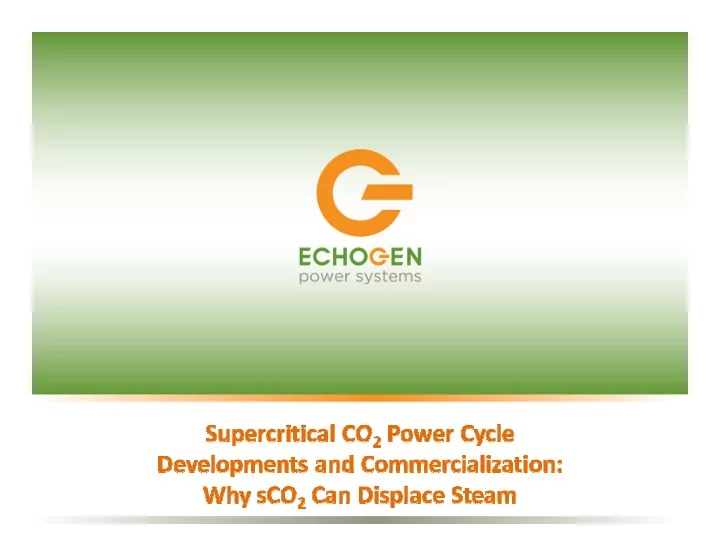

Power cycle development • Steam cycles dominant for >300 yrs, mostly Rankine • Gas Brayton cycles – catching up last 50 years • Organic Rankine Cycles (ORC) relatively recent 2
Why a new power cycle? • Steam – Good efficiency at lower turbine inlet temperature • Low compression work (pumping incompressible liquid) • High expansion ratio (large work extraction / unit mass of fluid) – 2-phase heat addition limits turbine inlet temperature – Expansion into 2-phase region = blade erosion – Corrosion, water treatment issues 3
Why a new power cycle? • Gas Brayton cycles – Good fuel-power conversion efficiency – Require high (combustion) turbine inlet temperatures for efficient operation – Compression work large fraction of developed power • ORC – Best solution at low temperatures, dry expansion – Working fluids are more difficult to handle – generally require secondary transfer loop, limits turbine inlet temperature 4
Characteristics of an ideal power cycle • Good utilization of available heat – High expansion, low compression work – Direct coupling to heat source • Benign working fluid – Non-corrosive, non-toxic, thermally stable – Dry expansion to avoid erosion • Low capital cost • Low operation & maintenance (O&M) costs Supercritical CO 2 meets these characteristics 5
sCO 2 cycle history • 1960’s – Feher proposes use of a recuperated closed-loop sCO 2 based power cycle – Recognized that CO 2 properties allow for Brayton-style cycle, but with Rankine-like compression work • 2000’s – MIT, Sandia, others consider sCO 2 nuclear power cycle – Three “Supercritical CO 2 Power Cycle” Symposia – 2008, Sandia builds small sCO 2 test loop for turbomachinery (simple and recompression cycles) • 2007 – Echogen founded with vision of commercializing a sCO 2 waste heat recovery heat engine – 2009, builds ~ 250kWe demonstration simple cycle system – 2011, begins construction of 7.5MWe commercial system 6
sCO 2 cycles – Simple recuperated cycle Compact equipment set Supercritical fluid Subcooled liquid Superheated 2-phase vapor Good heat utilization at low heat source temperature 7
High density fluid = compact equipment: Heat exchangers >15MW >300m² heat transfer area ~13000kg Core ~ 1.5 x 1.5 x 0.5 m Comparable S&T: >850m² ~50000kg Shell ~ 1.2m diameter x 12m length 8
High density fluid = compact equipment: Turbomachinery 10MW sCO 2 turbine Non-condensing expansion 10MW steam turbine Condensing expansion 9
Simple single-phase exhaust heat exchangers Constant temperature Continuous boiling process temperature increase Boiling process in steam systems limits maximum fluid temperature, requires • multiple pressures to achieve close approach to exhaust temperature ORC systems require intermediate heat transfer loop, plus boiling heat transfer • 10
CO2 cycles – The challenge with a simple recuperated architecture Heat addition Expansion work Compression work Low pressure ratio cycle => recuperation => can limit � T of heat addition 11
CO2 cycles – Simple cycle limitations Heat addition Highly recuperated cycle limits performance at higher heat source temperature 12
CO2 cycles – Cascading can increase available � T Heat addition Heat extraction limitations of simple recuperated cycle mitigated 13
CO2 cycles – recompression yields high heat to power efficiency, but very low � T Heat addition Recompression cycle specifically designed for low � T applications (nuclear, CSP) 14
Applications of the sCO 2 cycle Exhaust & waste heat recovery (Moderate T, high DT) Concentrated Solar Thermal (CSP) (High T, low DT) Topping cycle (High T, low DT) Geothermal (Low T, thermosiphon)
250 kW demonstration system: initial field tests completed at American Electric Power (AEP) Designed for full access Commercial size demonstration and ease of maintenance unit at AEP’s test facility Shop packaged / modular design Measured performance in line with cycle model for ease of installation predictions – 140 hours, 93 turbine starts 16
250 kW demonstration system: long-term tests at Akron Energy Systems (AES) during 2012 Hardware transferred and delivered by truck Cooling tower installation Heat engine delivery and placement System installation now underway 17
First “commercial-scale” system at ~7.5MW, utilizes commercial technology From Sandia National Laboratory report 18
First 7.5MW system is currently in fabrication Subsystem and component testing planned for 3Q through 4Q 2012 Full system installation and testing in early 2013 19
System installation comparison: 7.5MW steam vs. sCO2 Steam sCO 2 Gas turbine Smaller installation footprint compared to a HRSG/steam system for gas turbine bottom cycling 20
sCO 2 = Higher power at lower CAPEX for CCGT applications sCO 2 + LM2500 Net power (kWe) Installed cost DP-HRSG + LM2500 SP-HRSG + LM2500 LM2500 Simple Cycle DP HRSG sCO2 Ambient temperature ( ° C) • High output power + low cost + low O&M = low LCOE • sCO 2 the clear solution for gas turbine heat recovery 21
Levelized Cost of Electricity (LCOE) � The Key Performance Metric Lower capex of sCO 2 system provides major advantage • Faster startup times (~20min vs 45-90 min for steam) = higher • average output in peaking applications Lower footprint, zero water usage in dry-cooled applications • 22
Summary • sCO 2 cycles have significant advantages in several applications over steam – Good thermodynamic performance – Low installed capex – Favorable LCOE • Broad range of applications under consideration • Waste heat recovery first commercial application – Demonstration system proved feasibility – First full-scale application in 2013 23
Recommend
More recommend